load balancing and failover (LBFO)
HOTSPOT
Your on-premises network contains a server named Server1 and uses an IP address space of 192.168.10.0/24.
You have an Azure virtual network that contains a subnet named Subnet1. Subnet1 uses an IP address space of 192.168.10.0/24.
You need to migrate Server1 to Subnet1. You must use Azure Extended Network to maintain the existing IP address of Server1.
What is the minimum number of virtual machines that you should deploy? To answer, select the appropriate options in the answer area.
NOTE: Each correct selection is worth one point.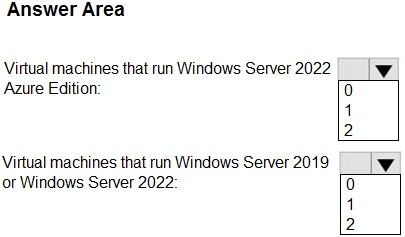
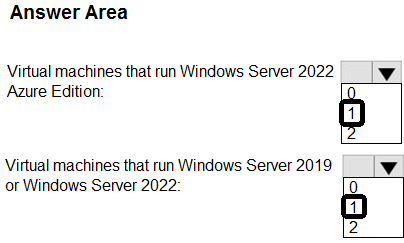
Your network contains an on-premises Active Directory Domain Services (AD DS) domain named contoso.com. The domain contains three servers that run
Windows Server and have the Hyper-V server role installed. Each server has a Switch Embedded Teaming (SET) team.
You need to verify that Remote Direct Memory Access (RDMA) and all the required Windows Server settings are configured properly on each server to support an
Azure Stack HCI cluster.
What should you use?
d
Reference:
https://github.com/Microsoft/Validate-DCB
You have a server that runs Windows Server 2022 and has the network adapters shown in the following table.
You need to configure NIC teaming for LAN2 and LAN3. The solution must support Dynamic Virtual Machine Multi-Queue (d.VMMQ).
What should you use?
b
load balancing and failover (LBFO)
Your network contains an Active Directory Domain Services (AD DS) forest. The forest contains three domains. Each domain contains 10 domain controllers.
You plan to store a DNS zone in a custom Active Directory partition.
You need to create the Active Directory partition for the zone. The partition must replicate to only four of the domain controllers.
What should you use?
d
DRAG DROP You deploy a single-domain Active Directory Domain Services (AD DS) forest named contoso.com.
You deploy five servers to the domain. You add the servers to a group named ITFarmHosts.
You plan to configure a Network Load Balancing (NLB) cluster named NLBCluster.contoso.com that will contain the five servers.
You need to ensure that the NLB service on the nodes of the cluster can use a group managed service account (gMSA) to authenticate.
Which three PowerShell cmdlets should you run in sequence? To answer, move the appropriate cmdlets from the list of cmdlets to the answer area and arrange them in the correct order.
Select and Place: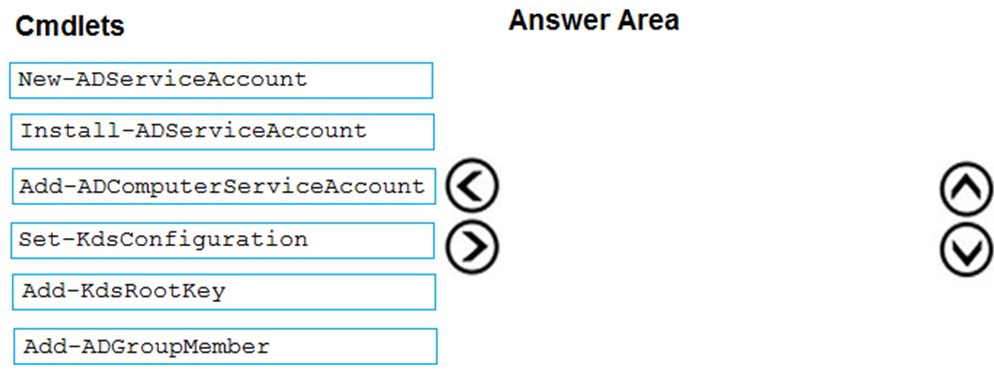
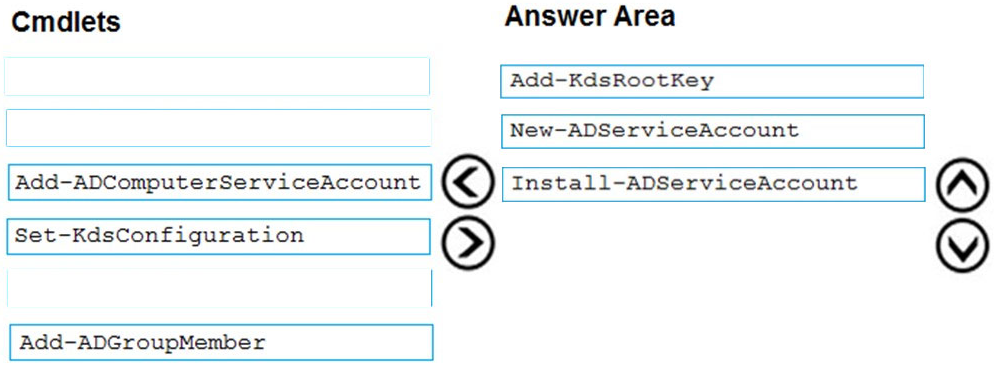
Reference:
https://docs.microsoft.com/en-us/windows-server/security/group-managed-service-accounts/create-the-key-distribution-services-kds-root-key https://docs.microsoft.com/en-us/windows-server/security/group-managed-service-accounts/getting-started-with-group-managed-service-accounts
HOTSPOT You plan to deploy an Azure virtual machine that will run Windows Server.
You need to ensure that an Azure Active Directory (Azure AD) user named [email protected] can connect to the virtual machine by using the Azure Serial
Console.
What should you do? To answer, select the appropriate options in the answer area.
NOTE: Each correct selection is worth one point.
Hot Area: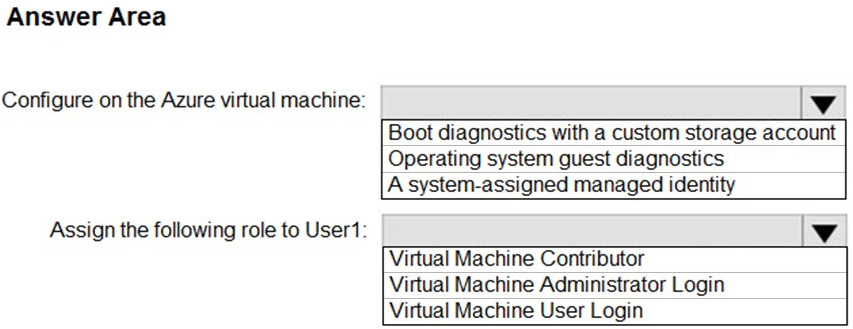
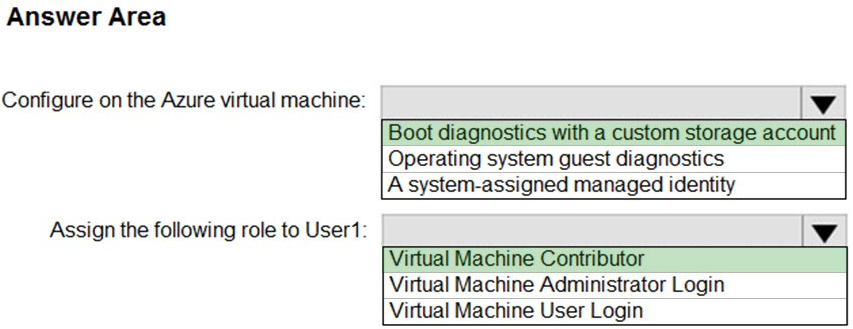
Reference:
https://docs.microsoft.com/en-us/troubleshoot/azure/virtual-machines/serial-console-overview
SIMULATION
You need to configure a Group Policy preference to ensure that users in the organizational unit (OU) named Server Admins have a shortcut to a folder named \\srv1.contoso.com\data on their desktop when they sign in to the computers in the domain.
To complete this task, sign in the required computer or computers.
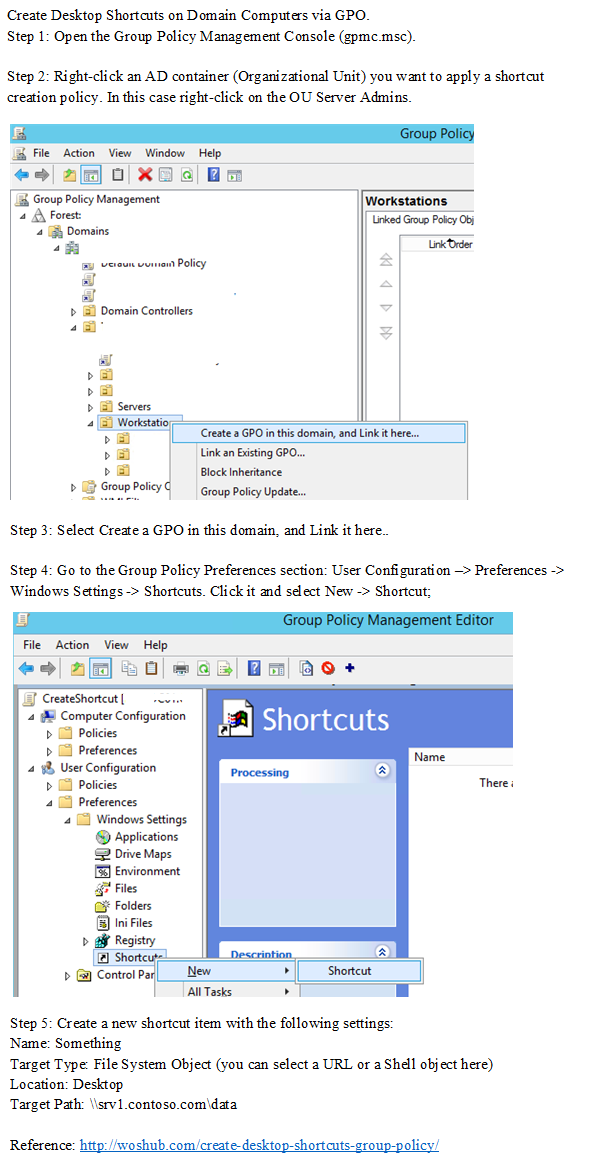
SIMULATION
You need to run a container that uses the mcr.microsoft.com/windows/servercore/iis image on SRV1. Port 80 on the container must be published to port 5001 on SRV1 and the container must run in the background.
To complete this task, sign in to the required computer or computers.

DRAG DROP
Case Study
This is a case study. Case studies are not timed separately. You can use as much exam time as you would like to complete each case. However, there may be additional case studies and sections on this exam. You must manage your time to ensure that you are able to complete all questions included on this exam in the time provided.
To answer the questions included in a case study, you will need to reference information that is provided in the case study. Case studies might contain exhibits and other resources that provide more information about the scenario that is described in the case study. Each question is independent of the other questions in this case study.
At the end of this case study, a review screen will appear. This screen allows you to review your answers and to make changes before you move to the next section of the exam. After you begin a new section, you cannot return to this section.
To start the case study
To display the first question in this case study, click the Next button. Use the buttons in the left pane to explore the content of the case study before you answer the questions. Clicking these buttons displays information such as business requirements, existing environment, and problem statements. If the case study has an All Information tab, note that the information displayed is identical to the information displayed on the subsequent tabs. When you are ready to answer a question, click the Question button to return to the question.
Overview
Company Information
ADatum Corporation is a manufacturing company that has a main office in Seattle and two branch offices in Los Angeles and Montreal.
Fabrikam Partnership
ADatum recently partnered with 2 company named Fabrikam, Inc.
Fabrikam is a manufacturing company that has a main office in Boston and a branch office in Orlando.
Both companies intend to collaborate on several joint projects.
Existing Environment
ADatum AD DS Environment
The on-premises network of ADatum contains an Active Directory Domain Services (AD DS) forest named adatum.com.
The forest contains two domains named adatum.com and east.adatum.com and the domain controllers shown in the following table.
Fabrikam AD DS Environment
The on-premises network of Fabrikam contains an AD DS forest named fabrikam.com.
The forest contains two domains named fabrikam.com and south.fabrikam.com.
The fabrikam.com domain contains an organizational unit (OU) named Marketing.
Server Infrastructure
The adatum.com domain contains the servers shown in the following table.
HyperV1 contains the virtual machines shown in the following table.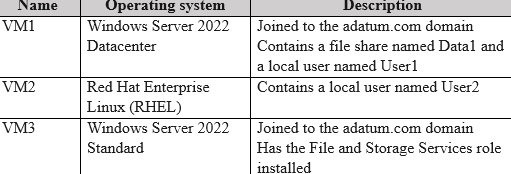
All the virtual machines on HyperV1 have only the default management tools installed.
SSPace1 contains the Storage Spaces virtual disks shown in the following table.
Azure Resources
ADatum has an Azure subscription that contains an Azure AD tenant. Azure AD Connect is configured to sync the adatum.com forest with Azure AD.
The subscription contains the virtual networks shown in the following table.
The subscription contains the Azure Private DNS zones shown in the following table.
The subscription contains the virtual machines shown in the following table.
All the servers are in a workgroup.
The subscription contains a storage account named storage1 that has a file share named share1.
Requirements
Planned Changes
ADatum plans to implement the following changes:
Sync Data1 to share1.
Configure an Azure runbook named Task1.
Enable Azure AD users to sign in to Server1.
Create an Azure DNS Private Resolver that has the following configurations:
Name: Private1
Region: West US
Virtual network: VNet1
Inbound endpoint: SubnetB
Enable users in the adatum.com domain to access the resources in the south.fabrikam.com domain.
Technical Requirements
ADatum identifies the following technical requirements:
The data on SSPace1 must be available always.
DC2 must become the schema master if DC1 fails.
VM3 must be configured to enable per-folder quotas.
Trusts must allow access to only the required resources.
The users in the Marketing OU must have access to storage1.
Azure Automanage must be used on all supported Azure virtual machines.
A direct SSH session must be used to manage all the supported virtual machines on HyperV1.
You need to implement the planned change for Data1.
Which actions should you perform in sequence? To answer, drag the appropriate actions to the correct order. Each action may be used once, more than once, or not at all. You may need to drag the split bar between panes or scroll to view content.
NOTE: Each correct selection is worth one point.
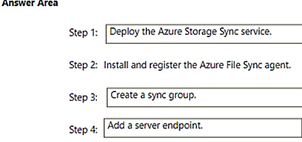
DRAG DROP You have a server named Server1 that runs Windows Server and has the Hyper V server role installed. Server1 hosts a virtual machine named VM1.
Server1 has an NVMe storage device. The device is currently assigned to VM1 by using Discrete Device Assignment.
You need to make the device available to Server1.
Which four actions should you perform in sequence? To answer, move the appropriate actions from the list of actions to the answer area and arrange them in the correct order.
Select and Place: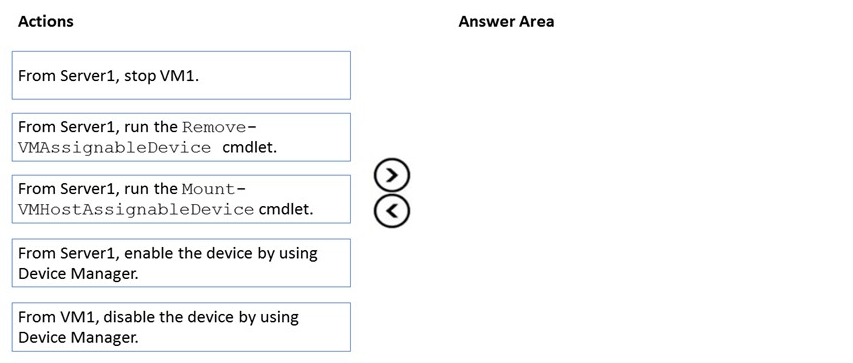
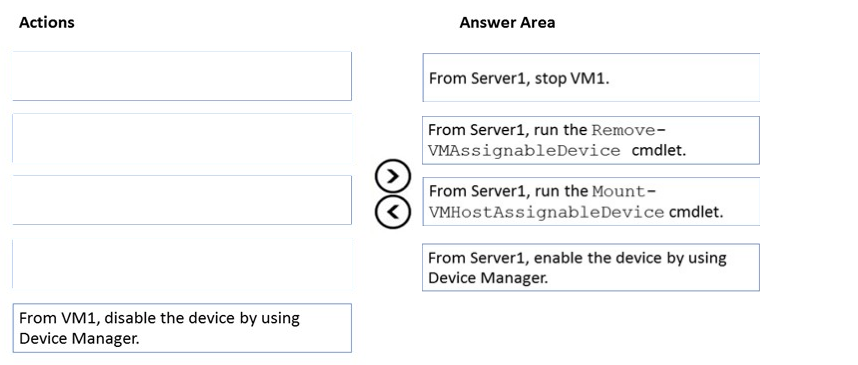
Reference:
https://docs.microsoft.com/en-us/windows-server/virtualization/hyper-v/deploy/deploying-storage-devices-using-dda
Box 1: 1
Box 2: 1
azure edition 1
win22 1
Azure Extended Network richiede:
Un server che ospita il ruolo di Network Controller (Windows Server 2022 Azure Edition).
Un server che funge da Gateway di Rete Virtuale (Windows Server 2019 o 2022 Azure Edition).
Questi due ruoli non possono essere combinati su una singola macchina virtuale.
Devi quindi avere due macchine virtuali separate, ciascuna con uno dei ruoli necessari per configurare la rete estesa.